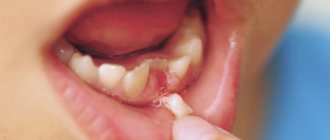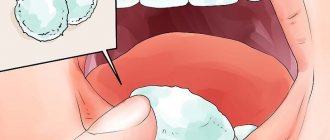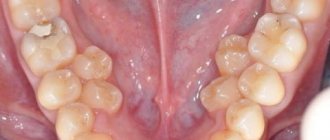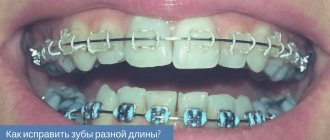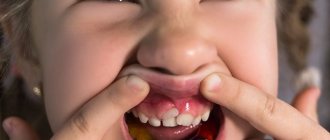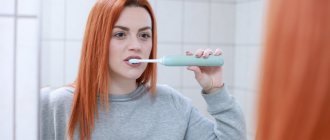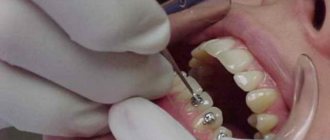Pediatric dentistry can be considered a separate section of modern dental practice, because due to the structural features, the treatment of baby teeth is somewhat different from the treatment of permanent teeth. Unfortunately, many parents are still convinced that baby teeth do not need dental care - after all, they will soon break down and fall out anyway. Therefore, children are not taken to the dentist very often, and if they are taken to the doctor, it is with advanced diseases and multiple problems.
In fact, dental treatment should be carried out at any age, and the sooner you consult a doctor with a problem, the higher the likelihood of getting rid of it quickly and without any complications. If a child has bad baby teeth, this will inevitably affect the health of his permanent ones - this is what parents need to remember when they want to “pity” the baby and not take him to an appointment with the “evil dentist.”
Gum inflammation
The most common inflammatory gum diseases in children are stomatitis and gingivitis. Stomatitis, or, as it is usually called, thrush, is an infectious inflammatory process provoked by fungi of the genus Candida. Treatment is antifungal and anti-inflammatory therapy, always carried out under the supervision and recommendations of a dentist. Self-medication can be dangerous, as some children may have allergic reactions to certain medications or antiseptics.
Gingivitis most often occurs due to plaque on baby teeth and insufficient general hygiene, but the reasons for their development can also be trauma to the gums during teething or other injuries, untreated caries. With this problem, you also need to contact a doctor, who will select the optimal treatment regimen and prevent gingivitis from developing into childhood periodontitis.
First examination of a newborn
Immediately after birth, the baby is examined by specialists, including a dentist. This is important because an assessment of the general condition and reflexes is necessary, but the primary question is the size of the frenulum of the tongue. With a shortened frenulum, the child will not be able to grasp the nipple and suck normally. External examination and assessment of tongue movement does not always reveal abnormalities. This may appear in the next 5-15 days:
- smacking sounds appear during feeding;
- a long feeding process: the baby sucks, then pauses for a while and starts sucking again;
- Mom develops cracks and pain in her nipples;
- the child is capricious at the breast;
- is gaining weight poorly.
If such symptoms are noticed, you should make an appointment with a doctor so that he can examine the baby, determine the size of the frenulum and make the appropriate prescriptions.
Caries, pulpitis and periodontitis of primary teeth in children
Milk teeth have thinner enamel and dentin layers than permanent teeth, they have a larger pulp chamber and, therefore, infection spreads faster to the pulp. They are more often susceptible to carious lesions - and not least because of night feeding or the habit of drinking drinks from a bottle at night (mostly sweet or sweetened - tea, juices).
In addition, caries is often provoked by plaque on baby teeth, which forms faster than in adults, and which not all parents are in a hurry to remove. Many people begin brushing their children’s teeth at a more or less conscious age, while a child should be taught hygiene and regularly remove plaque from the moment the first teeth erupt, that is, from about six months of age. Also, the cause of diseases of the dental system can be an insufficient amount of solid food in the baby’s diet, since chewing solid food helps to clean the dental surfaces themselves.
The child's nutritional habits, lack of hygiene, and too thin enamel layer provoke a phenomenon called circular caries of baby teeth - carious lesions spread over the entire tooth surface, as if encircling the crown.
Caries quickly turns into pulpitis - an inflammatory lesion of the dental pulp. Most often, a doctor is consulted precisely at this stage of the infectious process, ignoring the initial stages of damage to dental tissues. Pulpitis, in turn, provokes periodontitis of primary teeth in children - inflammation of the periodontal tissues near the tips of the tooth roots. This condition is usually accompanied by severe pain, severe swelling of the affected area, and often an increase in body temperature.
Is it possible to cure caries in a child without drilling? What methods are there?
It is possible if the carious cavity is at the initial stage.
- Remineralizing therapy.
- Treatment method with the Icon system.
- In some cases, we replace the drill with a RONDOflex device - this is an air-abrasive handpiece. Preparation occurs using a mixture of water jet and aluminum oxide powder. The treatment proceeds in a gentle manner and is not accompanied by noise, vibration, or unpleasant sensations.
Unfortunately, most often parents bring their child to the clinic when a tooth is already bothering him and the baby complains of discomfort or pain. Usually this is already the stage of pulpitis. In these cases, treatment without a drill is impossible.
IMPORTANT! I always recommend my patients to come for a preventive examination 2 times a year, even if there are no complaints. Often pathological processes in the tooth are asymptomatic.
Treatment of baby teeth
At the initial stages, caries is treated without tissue preparation - remineralization of the enamel, as well as modern Icon technology, which allows filling without drilling, easily cope with carious lesions of the enamel layer. In later stages, when the dentinal layer is affected, as well as in the case of pulpitis and periodontitis, treatment of baby teeth with tissue preparation will be required. You should not be afraid of such procedures - modern methods of anesthesia allow them to be carried out completely painlessly and comfortably for a small patient. In addition, the anesthetics used are harmless, with a minimum concentration of the active substance. And the site of the upcoming injection itself is numbed by applying a special gel or spray (application anesthesia).
Experienced dentists try to carry out treatment quickly so that the child does not have time to get tired and capricious. If a child has bad baby teeth and a large amount of work is required, it is divided into several stages. It also happens that the child does not want to contact the doctor, is too afraid of treatment, or the volume of manipulation is too large and serious - in such a situation, it is possible to carry out therapy under anesthesia or with intravenous sedation (with a preliminary examination).
In case of pulpitis, the root canals are filled with special pastes that dissolve simultaneously with the “milky” root, so there is no chance that the medicinal material will remain in the tooth socket and will prevent the new tooth from growing properly.
Treatment of caries without a drill
Modern pediatric dentistry offers treatment of caries without the use of a drill:
- Silvering . This method is excellent for treating initial caries. The dentist cleans the affected surface and treats it with a 30% silver nitrate solution, after which a protective film is formed that prevents the further development of caries. The procedure takes only a few minutes and is absolutely painless and non-toxic for the baby.
- Remineralization . The procedure is aimed at restoring the mineral composition of enamel and dentin.
- Ozone therapy also makes it possible to treat initial caries without preparation. The method is based on the destruction of carious lesions using ozone molecules.
- Laser treatment of caries has been successfully used in pediatric dentistry. The treatment is painless and does not require anesthesia.
- Chemicals . Treatment is carried out without a drill; the doctor removes damaged tissue using a special gel.
- Icon is a modern method of treating initial caries. To prevent the development of caries, the affected area is sealed using a special polymer.
Restoration of baby teeth
If a child’s baby tooth breaks off or if the dental crown is severely damaged by caries, restoration is carried out. However, if for adult patients one of the most important aspects during restoration is aesthetics, then for children functionality is much more important. Therefore, restorative filling materials are always selected taking into account the patient’s age - for children, durability and impeccable aesthetics are not so important, a good marginal fit of the fillings and the preservation of dental tissues are much more important. Filling materials that are too strong can put pressure on dental tissues and contribute to their destruction, and therefore dentists choose materials that will recreate and maintain the integrity of the dental crown until the moment of natural tooth loss.
Removal of baby teeth in children
Removal of baby teeth in children is carried out only for specific indications or in the case when the tooth is ready to fall out on its own and just needs a little “help”. If there is a choice - to remove or treat, a competent dentist will always advise treatment, since the early loss of baby teeth leads to a number of serious disorders of the dental system, including the appearance of permanent bite defects.
Extraction operations should be carried out exclusively in the dentist’s office - attempts to remove teeth at home can lead to injury to soft tissues, infection of the socket, injury to the rudiment of a permanent dental unit, etc. The doctor will perform the extraction under local anesthesia quickly, competently and completely painlessly.
At what age should a child be taken to the dentist for the first time?
According to the WHO schedule, you should go to the dentist for the first time when the child is 9 months old. Some doctors indicate an age of 11-12 months. During a dental examination, several parameters are assessed.
1. How many teeth are there?
Based on the number of teeth present, the child’s development is assessed and pathologies are diagnosed. It is normal for children to erupt 5-8 milk teeth by the age of 9-12 months.
2. What condition are the teeth in?
From the first days of teeth appearing there is a danger of caries. Also, teeth should be examined for non-carious lesions - hypoplasia, in order to exclude the appearance and development of caries.
3. What is the condition of the mucous membranes?
Small children put everything in their mouths, so they are at risk for infectious diseases - stomatitis and intestinal infections. The more common fungal form of stomatitis, which must be treated promptly to avoid complications.
At the age of 9-12 months, a dental examination is more necessary for preventive purposes. The doctor will tell you what toothpaste to use, what toothbrush to choose, and how to teach your child hygiene. Until the child reaches two or three years of age, visits to the dentist should be regular - every 3-5 months.
What to do if baby teeth grow crookedly?
If parents notice that their child’s baby teeth are growing crookedly - for example, there is crowding or improper occlusion - this is a reason for a mandatory consultation with a pediatric orthodontist. It happens that due to anomalies of the facial skeleton (in particular, improper development of the jaws), defects are noticeable even with a primary bite, and with a permanent bite they will persist and worsen.
Therefore, it is recommended to show the child to an orthodontist from the age of three to determine whether there is pathology and find methods for its correction. There are malocclusions that are easily corrected at an early age and extremely difficult to correct in adults.
How to protect baby teeth from caries?
Prevention is the best way to cope with any disease. Therefore, those parents who care about the health of their children should definitely think about caries prevention. How to protect baby teeth from caries? The recommendations of experts in this matter are as follows:
- The correct diet for the mother during pregnancy is with a sufficient amount of foods containing calcium, fluorine and phosphorus: cottage cheese, beef and beef liver, sea fish, nuts, fruits and vegetables, cereal porridges.
- Compliance with hygiene standards: daily brushing from the moment the first teeth appear, first with a cotton or gauze swab with boiled water, then with special baby brushes and pastes. Plaque on baby teeth should be removed promptly and thoroughly.
- A healthy diet for a child: as little fast carbohydrates, carbonated drinks, sweets as possible, more fruits and vegetables, cereals, and dairy products.
- Timely visits to the dentist for preventive examinations (at least once every six months).
It is important that parents develop a conscious attitude towards the health of their children's teeth and oral cavity in general. A timely visit to the dentist in case of any identified problems, as well as for regular medical examinations, will help maintain the health of the child’s dental system – and therefore the digestive system too.
Is it possible to completely prevent the development of caries in childhood?
Perhaps, if parents conscientiously follow all the doctor’s recommendations regarding nutrition and the prevention of carious lesions, they systematically come for preventive examinations, which are prescribed by the attending physician.
It is necessary to take care of baby teeth and carry out treatment in a timely manner. You need to take care of your child’s teeth from the appearance of the first tooth. Parents should approach oral care responsibly, teaching their child to take care of hygiene. It is not difficult to interest a child now - parents will be helped by unusually designed toothbrushes, pleasant-tasting toothpastes, and, if desired, even such a routine activity as brushing teeth can be turned into an interesting game.
Pediatric dentistry will help you - during your appointment at our clinic, hygiene lessons are held - specialists tell and show how to properly brush your teeth. Let your children be healthy, happy and smiling!

